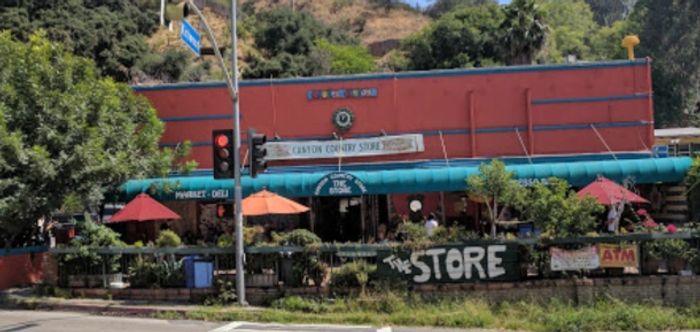Laurel Canyon Country Store

"The Heart of Laurel Canyon"

"The Heart of Laurel Canyon"

Tommy Bina is owner of the legendary Canyon Country Store.
.jpg/:/cr=t:0%25,l:12.32%25,w:75.37%25,h:100%25/rs=w:600,h:451.12781954887214,cg:true)
Located halfway up Laurel Canyon, the store was immortalized by The Doors in the song Love Street as the “store where the creatures meet.” It was originally built in 1919 as a lodge for local hunters accessible only by trackless trolley. Wild with coyotes, rattlesnakes, deer, and rabbits, the area became a prime hunting spot, and Charles Spencer Mann began developing the area with small cabins catering to hunters and dubbing it Bungalow Land. The Bungalow Lodge and Tavern opened at Kirkwood and Laurel Canyon, serving mostly the hunters visiting the area. In 1929 the lodge burned, and the following year it was rebuilt using brick and stones from the old riverbed and turned into the market we see today.

As Hollywood began making movies, the film stars found their way into the steep drives of Laurel Canyon. Actors such as Orson Welles, Clara Bow and Errol Flynn all lived here. In fact the house Frank Zappa would eventually move in to once belonged to western star, Tom Mix. In 1948 canyon resident and iconic actor Robert Mitchum was arrested for pot, and the cops said the canyon was “ideally situated to be a ‘reefer resort.'” Little did they know what lay ahead.

By the 1960s, a new wave of canyon residents arrived, with their guitars, drugs, and free love attitudes. A short drive to the Sunset Strip, Laurel Canyon became a haven for the musicians of the time. Jim Morrison of The Doors was among them, living behind the Canyon Country Store on Rothdell Trail with his girlfriend Pamela Courson. It’s said that a fight broke out and those at the store could see Morrison’s belongings such as books and clothes being tossed from the windows. Morrison also wrote the song “Love Street” about Laurel Canyon, and the Canyon Country Store is the “store where the creatures meet” as the store became a place for impromptu jam sessions with the various artists.

Mama Cass, of the Mamas and the Papas lived in the basement of the Canyon Country Store for a period of time, the space is now home to Pace, an Italian restaurant. Mama Cass would later go on to introduce Graham Nash to David Crosby and Stephen Stills…maybe. Thanks to a near constant party atmosphere and lots of drugs, everyone remembers things differently. Stills said it happened at Mama Cass’, Nash is unsure, and Crosby, along with Elliot Roberts, Joni Mitchell’s manager, said it happened at Mitchell’s. But regardless of exactly whose house, it did happen in the canyon.

The Mamas and the Papas would also contribute the song “Twelve Thirty” which is about the canyon and the groupies who would walk through. “John [Philipps] began that song in New York but he didn’t know what to do with it. When we moved out here, the canyon fit the bill perfectly. Everybody was up there, and all the young girls were looking for the rock stars. They’d wander the hills calling out their names,” Denny Doherty of the Mamas the Papas recalled.

Chris Hillman lived in Laurel Canyon and called it the "Woodstock of the West." Hillman wasn’t the only Byrd living in the canyon, David Crosby did and Gram Parsons later moved there as well, and Mickey Dolenz and Peter Tork of The Monkees lived there too, and cross-over country female vocalists such as Bonnie Raitt and Linda Ronstadt resided there as well. The canyon was a melting pot of people from all over, who came together and created a unique sound for a very specific time and place, but is also incredibly timeless.

Not only did the canyon provide a certain sound, it also provided literal lyrics, and sometimes whole albums. As mentioned, The Doors’ “Love Street” and the Mamas and the Papas song “Twelve Thirty” are both in reference to Laurel Canyon, but they aren’t the only ones. Crosby, Stills, & Nash wrote “Our House” about their home in the canyon. Joni Mitchell dubbed one of her albums, Ladies of the Canyon, after the area and John Mayall also had an entire album inspired by the canyon called Blues from Laurel Canyon, and it included the track “Laurel Canyon Home.”

Standing in front of the Canyon Country Store, a large metal basket hold bundles of firewood, a sign hanging on it reads "Come On Baby Light My Fire.”

Many of the musicians who lived there had an open door policy, with people crashing on couches, jam sessions, and parties. However nearly of that would change as the 1960s came to a close. The end of the era is often blamed on the drugs, success, burn out, the disaster of Altamont, and the Manson murders.

When the 80s arrived the canyon became known for its cocaine, with it being as easy to obtain as asking someone in the parking lot of the Canyon Country Store for some.

Yet the mythos of Laurel Canyon’s heyday lives on in the sounds that originated here.
While many of the pioneering musicians have left, a walk through the winding eucalyptus lined roads with their tunes playing in your head will still give you the same feeling as if they are still here.

Visit Laurel Canyon and experience the magic like never before! For the first time ever, take an in-depth behind the scenes walking tour of this rock and roll paradise in the heart of L.A.
Described by many as a bucket list item and once-in-a-lifetime experience, this tour is sure to be a highlight of your trip.
Laurel Canyon Country Store
Copyright © 2024 Laurel Canyon Country Store - All Rights Reserved.
Powered by GoDaddy
We use cookies to analyze website traffic and optimize your website experience. By accepting our use of cookies, your data will be aggregated with all other user data.